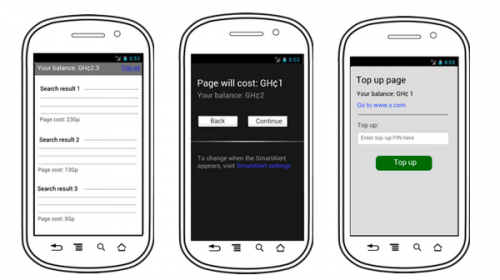Cost-consciousness a priority as more Africans access mobile data
More Africans are going online, usually via mobile phone. Pre-paid mobile service plans, the most common type of African mobile subscription, have allowed millions of customers to go online. However, such plans are confusing to understand and require knowledge of expiration periods, data limits, and bundles. There is weak understanding of airtime, mobile data use, and data balances. Price transparency is especially important in areas where Internet access is expensive and quality of service is low.
A 10-week Google study at the University of Ghana found that mobile internet users with greater price transparency were able to go online 7% more often and spend 19% less on Internet credit than a control group. New mobile data users who had a better understanding of online costs were even more efficient in managing mobile airtime/data spend. In addition, users felt they were making better decisions; 72% of users with real-time cost information said so. The findings were consistent across age and gender (though men generally spent more on data-heavy sites). Half of the money saved was due to a message warning a user that a page would be relatively expensive to load.
“I now know which site to visit and not to visit. I now spend little time to browse cos of cost involved. That is, I try to save credit.” – study participant
A February 2012 Google survey of mixed-income respondents in Nairobi, Kenya found respondents who knew of the relationship between the size of a webpage the cost needed to load it spent less money on mobile data. Those who did know understand the cost/data relationship were willing to pay more per megabyte.
A similar follow-up survey conducted in Ghana during June 2012 found only 19% of users could identify which mobile data activities were the most expensive. Most users monitored voice/SMS costs, but only 38% routinely checked their mobile internet balance.
As more people access mobile data (both for the first time and more often), there needs to be greater cost-consciousness. Subscribers are good at monitoring voice and SMS costs, but they are less aware of how little data can be had per dollar. Users need to be aware of their spending, especially before browsing expensive websites. An in-browser message is proven to succeed in this regard. The ability to find cheaper alternatives to data-heavy websites would help, too. Along the same lines, local web content should be designed with a frugal mobile user in mind. Finally, top-ups should be made easier as current methods (e.g. USSD codes) are error-prone.
Source: Sambasivan, N., Lee, P., Hecht, G., Aoki, P., Carrera, M., Chen, J., Cohn, D., Kruskall, P., Wetchler, E., Youssefmir, M. and Larssen, A. (2013). Chale, How Much it Cost to Browse? Results from a Mobile Data Price Transparency Trial in Ghana, Proceedings of the Sixth International Conference on Information and Communication Technologies and Development: Full Papers – Volume 1 (ICTD ’13), ACM, New York, NY, USA (2013), pp. 13-23.













 Twitter
Twitter Facebook
Facebook Pinterest
Pinterest